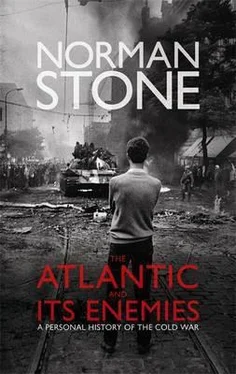Now, the Egyptian army (800,000 men with 2,200 tanks and 550 first-line aircraft) went into action. One key was that the Israeli air force would not be permitted to establish itself: in February 1972 the Egyptians were told in Moscow that they could have Soviet surface-to-air missiles — SAMs — that would constitute a ‘wall’ as well as the SCUD missiles that could land far in Israeli territory, to deter the Israelis from deep raids into Egypt. They arrived in May and Sadat started planning for war in January 1973. The Russians delivered fifty SAM batteries to Syria as well. Rumours were put about as to the Egyptians’ poor preparedness, and the mobilization just looked like another manoeuvre. There were arrangements in place for Soviet back-up, and in the meantime Sadat had co-ordinated with King Faisal that war and the oil weapon could go together. Secrecy was such that 95 per cent of the officers taken prisoner by the Israelis said that they only knew this would be a real attack on the morning of 6 October. Surprise was complete: 240 aircraft crossed the Canal to attack airfields, 2,000 guns opened up and fired 10,500 shells in the first minute. Tanks moved up the ramps and fired point-blank at the fortifications and then the first wave of infantrymen crossed at areas not covered by the Israeli strong-points: they had practised the manoeuvre dozens or even hundreds of times, sometimes by numbers. Such infantry could not be expected to act or learn otherwise. Ten bridges were to be thrown across the Canal. The Egyptians had expected up to 30,000 casualties on the crossing but these were extraordinarily light — 208 — and the bridges were ingeniously constructed so that a damaged section could easily be replaced. By midday on 7 October an Egyptian division was across and it prepared for counter-attack. But ‘the Israeli armour mounted what looked like old-fashioned cavalry charges’ which ‘made no sense whatsoever in the face of the masses of anti-tank weapons that the Egyptians had concentrated on the battlefield’. General Moshe Dayan himself gave a pessimistic briefing to the editors of the Israeli press and hinted that he might have to withdraw out of the Sinai altogether. However, the Egyptian follow-up was poor, and further attacks failed: the way was open to an Israeli counter-attack that reached even west of the Canal. But these three days had marked an Egyptian victory, for the first time ever, and that was Sadat’s essential point. A real victory would be the prelude to some settlement.
However, by 12 October the Israelis were receiving an American airlift to make up for the unforeseen losses and use of ammunition and aircraft. On 8 and 9 October Brezhnev appealed to other Arab states to join in and on the 10th set up an air bridge to Syria (Tito gave permission, saying it was for Sadat not Brezhnev that he agreed). On the 9th the Americans agreed to supply the Israelis, especially with electronic materiel that allowed Israeli planes to escape missiles, and to begin with the Israelis did the transporting, but the US air force did it from the 12th, as Israeli aircraft were not enough for these supplies. The decisive moment occurred on 14 October. There were 1,000 Egyptian tanks on the east bank, and they launched one of the largest tank battles in history: the missiles were out of range and so the Israeli air force could act decisively. The Egyptians lost 264 tanks, the Israelis ten. The SS11 anti-tank guided missiles had been important and the Israelis’ tanks were also well prepared — in fact the Egyptians had attacked only in response to appeals from Syria, where the fighting was not going well: on the Golan Heights there was a desperate battle but 867 Syrian tanks were left there. Now the Israelis could plan their own crossing of the Canal, succeeding on the 16th, and the Egyptians began to collapse. Within two days an Egyptian army was under threat of being cut off and the USSR proposed a ceasefire, the proposal being agreed between Brezhnev and Kissinger and presented through the United Nations. On the 24th a second UN resolution was put through because the Russians could foresee the collapse of their allies, and under American pressure the Israelis accepted it, their forces now even threatening Cairo. The Russians had mobilized airborne divisions for a move to the Middle East when the ceasefire came, but Sadat himself was not enthusiastic. Of course, it was yet another Arab defeat, in the end, but there was something to show for it. The upshot of the Yom Kippur war was not clear-cut. The French and the Germans made difficulties for Israel; Bonn refused the Americans an air bridge over Germany. At the end of the year all sides did meet for the first time and in mid-January 1974 there was a new arrangement — a neutral zone on the east bank. Egypt restored diplomatic relations with the USA in 1974 and broke with the USSR in 1976; two years later, on American territory (Camp David, the President’s official retreat), there was an Egyptian-Israeli peace. Israel evacuated Sinai.
It was now Arabs who used the oil weapon. On 16 October 1973 they put up prices by 70 per cent and on the 17th OPEC announced a reduction of output by 25 per cent and an embargo on the USA and Holland. On 23 December there was a doubling of Persian Gulf prices. OPEC announced that the price would rise to $5.11, and there was a further threat, that production would be cut by 5 per cent every month — the claim being that this was necessary for the Americans to force Israel into serious negotiations. Kissinger, in his aircraft, even learned that the Saudis would join the embargo on oil sales to America and her allies because of President Nixon’s public offer of $2bn in aid for Israel. On 21 October the Arabs stated that they would nationalize the oil companies if they failed to join the embargo against the USA, the whole affair occurring in the context of the Watergate revelations, and Nixon had just lost his corrupt Vice-President, Spiro Agnew, over tax fraud. The oil embargo went ahead, against Holland (which had stood up for Israel’s cause) and the USA, and even against the American ships supposedly protecting the Saudis. The price climbed and production fell back — from over 20 million barrels early in October to 15 million; and although Iran stepped up production somewhat (600,000) overall supply by December had fallen by 4 million barrels per day. This was about a tenth of consumption, but since consumption had been rising at 7.5 per cent per annum, the dent was more severe, and in any case panic caused damage, as the companies realized what was happening. They bid for any oil on the market, anywhere — in Nigeria, in November, $16 and then $22.60; in Iran, $17. The official price went up, from $1.80 in 1970 to $2.18 in 1971, $2.90 in summer 1973, $5.12 in October and $11.65 in December. By 23 December the Gulf States had doubled the price, and of course the rise in oil and natural gas prices much profited the Soviet Union. Boris Ponomarev, of the International Department, thought the crisis of capitalism was at hand. The centre was not holding.
This disintegration of the Marshall-NATO world had a cultural aspect. The biggest sign of this by far was in France, and perhaps not by chance. De Gaulle had greatly angered the Americans, with his withdrawal from NATO and his torpedoing of the dollar. France, in 1968, appeared to be extraordinarily successful, but de Gaulle received, out of the blue, a vast humiliation. In a moment that summed up the sixties, the students of Paris rebelled against him, and would have brought him down if the Communist Party had not, for Moscow’s sake, saved him. The episode in itself was farcical, but it was farce with a sinister side, edging into terrorism; it also did great damage to education in general, and particularly to European universities, which since then have declined. In 1914, as a foreigner, you beat your path to Paris or Berlin if you wanted to study anything of seriousness. By 1980 American universities were all the rage, and foreigners made for the universities of France or Germany only if they had no American (or at least British) alternative.
Читать дальше












![Edward Ellis - Adrift on the Pacific - A Boys [sic] Story of the Sea and its Perils](/books/753342/edward-ellis-adrift-on-the-pacific-a-boys-sic-s-thumb.webp)